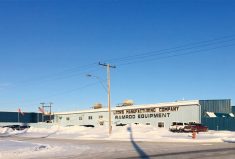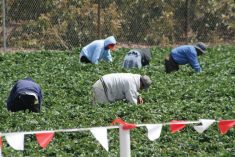Farm equipment sales in Canada dropped off significantly last year as farmers faced bad weather and even worse commodity prices.

“In short, (equipment sales) are not good. There’s no way to sugarcoat it,” said Curt Blades, senior vice-president of agricultural services for the Association of Equipment Manufacturers.
“Net farm income in Canada is down pretty sharply, so farmers are evaluating their business and determining whether or not it makes sense to make a capital investment this year. For lots of them, it’s just not in the cards.”
At the end of 2019, the Association of Equipment Manufacturers reported that combine sales dropped by 19 per cent from the same time the previous year, while farm tractor sales dropped nearly four per cent. And that’s not expected to turn around any time soon.
“The main thing that really affects equipment sales is certainty — or uncertainty,” said Blades. “2019 started out as a really good year for tractor and combine sales, and all of a sudden, there came some storm clouds around trade and price uncertainty. Those things affect the sale of equipment in a big way.”
Read Also

Farming Smarter receives financial boost from Alberta government for potato research
Farming Smarter near Lethbridge got a boost to its research equipment, thanks to the Alberta government’s increase in funding for research associations.
But it’s not all doom and gloom, Blades added.
Despite softer sales throughout 2019, the year ended at the five-year average, and for the last two years, Canada has been leading the North American replacement market.
“Equipment sales spiked quite nicely in 2018, so the equipment needs got filled, and then when the ag economy in Canada got a little softer, a lot of those equipment purchases were just getting deferred a little bit longer,” said Blades.
“That’s reflected in 2019, and I think that’s going to continue on to 2020.”
That’s the situation on Curtis Hoffman’s farm near Oyen.
“We’re not looking for anything this year. We kind of upgraded most of our main line in 2016, back when yields were good and markets were good,” said Hoffman, who used to budget for a major piece of equipment every year.
“But after 2016, we’ve had three droughts in a row, and commodity prices have crashed. We don’t really need the equipment, so we’re just putting that money more into debt than into equipment.”
Even if he were in the market, though, he wouldn’t be looking for anything new.
“I think equipment is overinflated right now,” said Hoffman. “The value of the machine doesn’t reflect the current economics or the market trends at the moment.”
Sky-high prices
Five years ago, the average new Class 7 combine ran right around $380,000. Today, that same combine is closer to $540,000 — a 42 per cent increase.
Tractor prices have also jumped, from around $120,000 five years ago to about $180,000 today for a front-wheel-drive tractor and $330,000 five years ago to $425,000 today for a four-wheel-drive tractor.
One of the things driving prices up is new technology, said Blades.
“There’s some pretty neat new technology, and a lot of farmers want to take advantage of it,” said Blades. “But those become a little bit more dependent on the overall farm economy, and with the farm economy being soft in Canada right now, that’s having an effect on some of those discretionary purchases.”
Hoffman agrees.
“All this new tech is kind of a waste for me because it’s not really going to gain me that much yield,” he said. “If we have three years of drought, it really isn’t going to pay off compared to what we would have to spend to get that equipment.
“I know a lot of farmers aren’t going to invest in a lot of this new tech until we see a turnaround in either yields or in commodity prices.”
But it’s not just the “fun stuff” like new guidance systems and precision agriculture tools that are driving up prices. It’s also the technology that’s needed to meet regulatory compliance, Blades added.
“It costs more to make a diesel engine that has fewer emissions, and these are the types of engines we have to use to be compliant from an environmental standpoint and from a safety standpoint,” he said.
Beyond that, “the cost of everything is going up — the cost of labour, the cost of fuel, the cost of transportation.”
“When we saw the steel and aluminum tariffs over the last couple of years, we basically saw a 20 to 30 per cent increase in steel,” said Blades. “So manufacturers have done a pretty good job across the board of holding prices as best they can, but their costs have certainly gone up because the raw materials have gone up.”
Strong recovery expected
That’s why Hoffman prefers to look for deals on Kijiji and at auctions.
“Equipment kind of follows the markets. The market goes up, equipment goes up right with it. But when markets come down, equipment prices lag a few years behind that,” he said.
“But if you go to an auction market, it’s a lot more direct. If the markets are down, people aren’t going to be interested in buying much that day. You can see quicker swings at the auction markets than at the dealers.”
But in 2020, as some of the uncertainties around trade and market prices start to clear, equipment sales should begin to rebound, with a strong recovery expected for 2021.
“Adding that certainty helps drive the market,” said Blades. “There are some other global issues there. We can talk about supply and demand, we can talk about the price of commodities, we can talk about all those other things, but at the end of the day, it comes down to whether the farmer feels good enough about their prospects for the next 12 to 18 months to invest in capital equipment.
“(That certainty) boosts confidence in farmers and in the industry, so those purchases become more likely.”
Even so, Hoffman doesn’t expect he’ll be buying any equipment this year.
“If we can find something we’re looking for at a reasonable price, we’d probably jump on it, but I’m fairly patient when it comes to buying new equipment,” he said.
“Most of my equipment will last another 10 years, so it gives me some time to look for deals in the meantime.
“There’s always a deal out there somewhere. You just have to look for it.”















